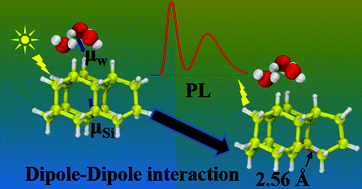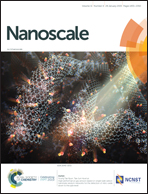A dipole–dipole interaction tuning the photoluminescence of silicon quantum dots in a water vapor environment†
Abstract
The optical properties of silicon quantum dots (Si QDs) depend on the working conditions, which are critical for their application in optoelectronic devices and fluorescent tags. However, how a humid environment, most common in daily life, influences the photoluminescence (PL) of Si QDs has not been fully understood yet. Herein, we applied time-dependent density functional calculations to show that the adsorption of water molecules would exhibit distinct effects on the PL spectra of Si QDs as a function of size. In particular, the PL of Si QDs presents dual band emission with the adsorption of the cyclic water trimer (H2O)3 under common humid conditions, completely different from the PL of Si QDs under other conditions. The transition dipole moment decomposition analysis shows that the additional emission peak originates from the single Si–Si stretched bond of Si QDs induced by the dipole–dipole interaction between the cyclic water trimer and Si QDs. Moreover, the PL characteristics are size dependent. As the size increases from Si17H24 (the diameter of 0.6 nm) to Si52H52 (1.4 nm), the dipole–dipole interaction energy between (H2O)3 and Si QDs rapidly decreases from 19.1 × 10−22 J to 6.0 × 10−26 J, resulting in a single peak of PL of (H2O)3 adsorption on Si52H52. This study not only gives a deep understanding of PL of Si QDs under humid conditions, but also provides a new perspective on the development of optical devices based on Si QDs.



 Please wait while we load your content...
Please wait while we load your content...